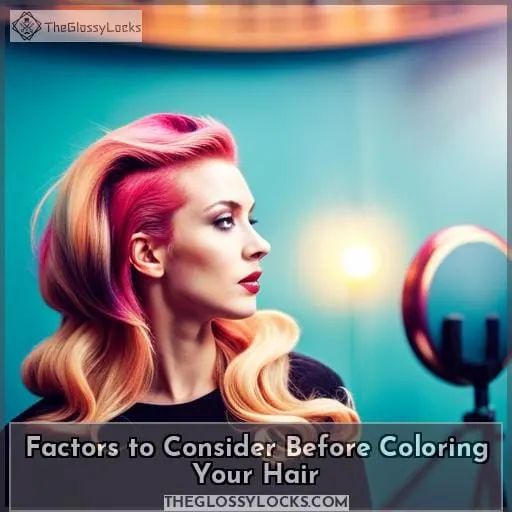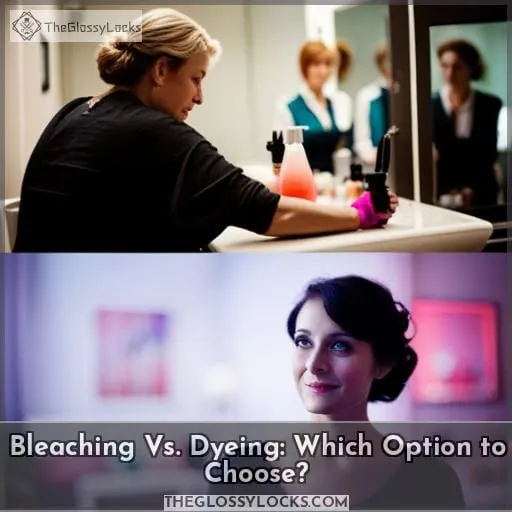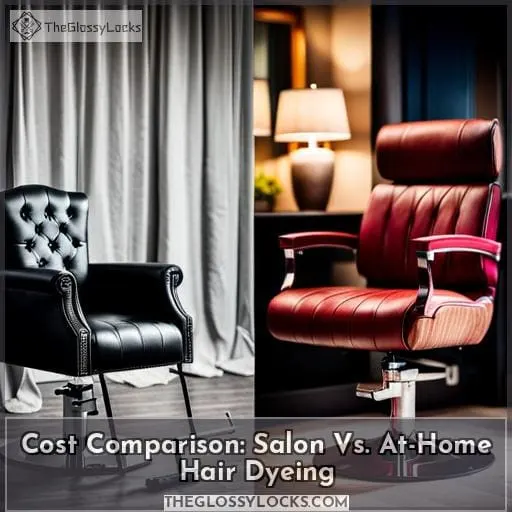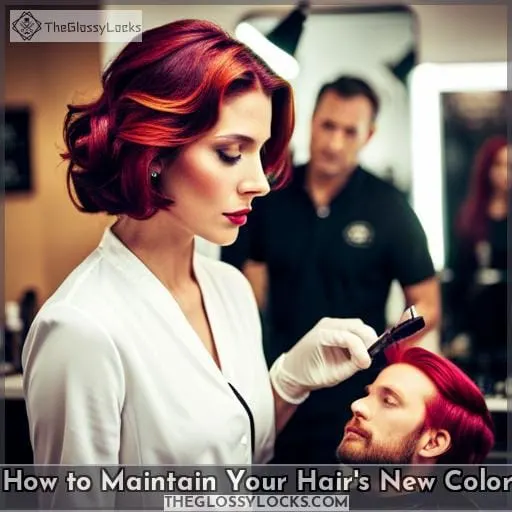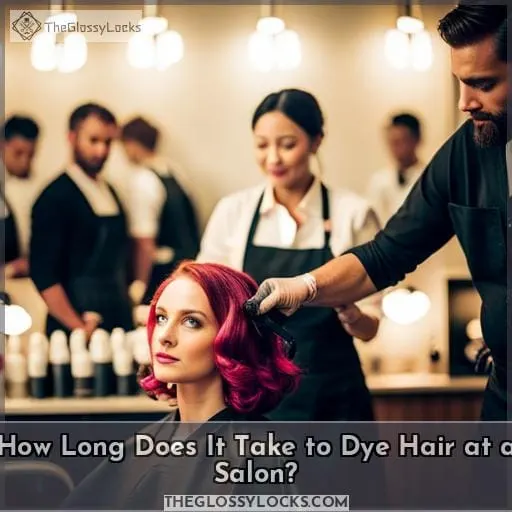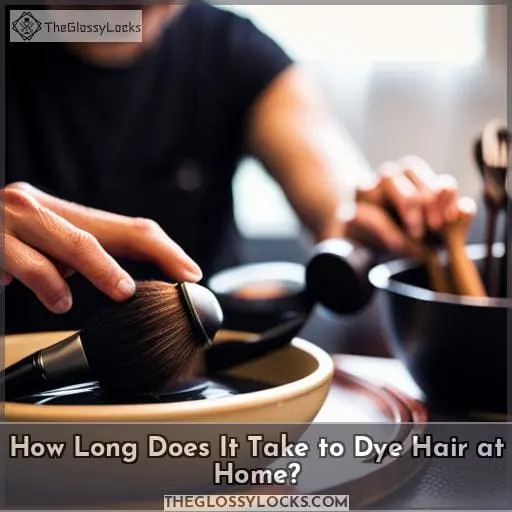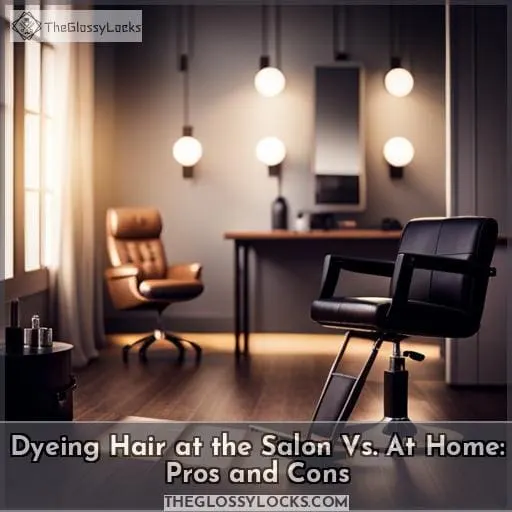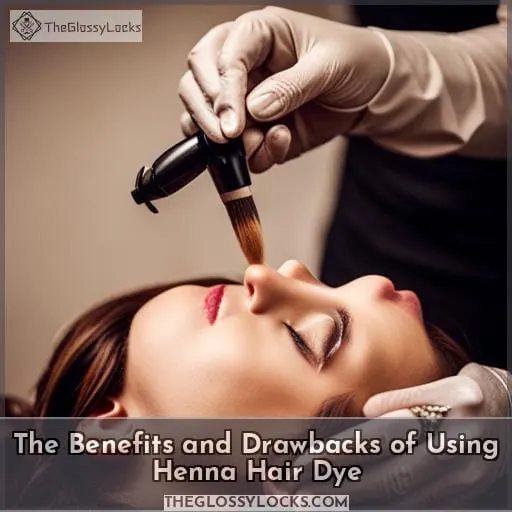This site is supported by our readers. We may earn a commission, at no cost to you, if you purchase through links.
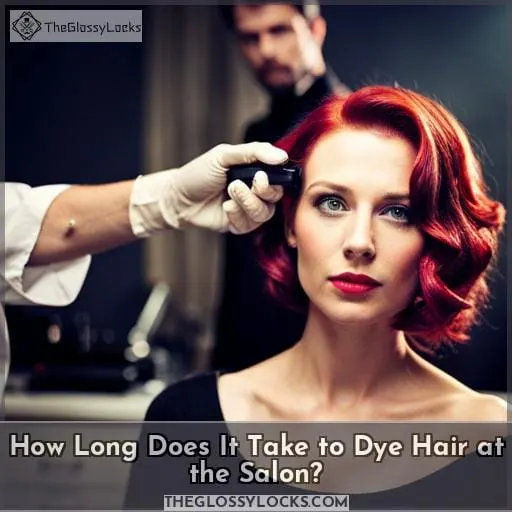 Imagine sitting in the salon chair, eagerly anticipating your hair transformation.
Imagine sitting in the salon chair, eagerly anticipating your hair transformation.
In this article, we’ll explore the factors that influence coloring time and give you a clear understanding of what to expect during each step of the process.
Table Of Contents
- Key Takeaways
- Factors to Consider Before Coloring Your Hair
- Bleaching Vs. Dyeing: Which Option to Choose?
- Cost Comparison: Salon Vs. At-Home Hair Dyeing
- How to Maintain Your Hair’s New Color
- How Long Does It Take to Dye Hair at a Salon?
- How Long Does It Take to Dye Hair at Home?
- Dyeing Hair at the Salon Vs. At Home: Pros and Cons
- The Benefits and Drawbacks of Using Henna Hair Dye
- Choosing the Best Brand of Henna Hair Dye
- Frequently Asked Questions (FAQs)
- Conclusion
Key Takeaways
- The salon process for dyeing hair can take 2-4 hours, while at-home dyeing takes under 1.5 hours.
- Salon treatments offer professional results with less damage, but home dyeing is more affordable.
- Time commitment should be considered when deciding between salon and home dyeing.
- Following instructions thoroughly is important for the best results at home.
Factors to Consider Before Coloring Your Hair
Before coloring your hair, there are several factors you should consider.
First, assess the condition of your hair to determine if it can handle the coloring process without causing excessive damage.
Next, think about your current and desired hair color and whether achieving that result will require bleaching or simply dyeing over natural color.
Additionally, take into account the density and texture of your hair as this can affect how long it takes for the dye to fully penetrate and develop on each strand.
Hair Condition
Before you dye your hair at the salon, consider the condition of your hair.
Dry and damaged hair may require extra care during the coloring process to prevent further damage.
Oily hair can affect how well the color adheres to your strands.
Healthy and strong hair is more likely to hold onto color and maintain vibrancy.
Brittle or weak strands may need additional treatments before or after coloring to ensure optimal results.
Take into account these factors when deciding on a new hue at a professional salon.
Current and Desired Hair Color
When considering coloring your hair at the salon, it’s important to evaluate both your current hair color and your desired outcome.
Take into account factors such as:
- Natural hair color
- Desired shade
- Any previous dyeing or bleaching treatments
Consider the density and texture of your hair as well since different colors may appear differently on various types of hair.
These considerations will help you achieve the best results when selecting a new hair color.
Hair Density and Texture
Consider your hair density and texture when deciding to dye your hair at the salon; it will affect how long the process takes.
- Fine hair tends to absorb color quickly, while thick hair may require more time for thorough coverage.
- Curly or wavy hair can be more challenging to dye evenly due to its texture.
- Additionally, damaged hair may require extra care and treatment during the coloring process.
Understanding your specific hair characteristics will help you make informed decisions about achieving your desired color effectively and efficiently.
Hair Type (Curly, Straight, Wavy)
If you have curly, straight, or wavy hair, it’s important to take your hair type into consideration when deciding to dye your hair.
Different types of hair have different porosity levels, densities, textures and coarsenesses which can affect how color is absorbed and processed.
Curly and coarse hair may require more time for the dye to penetrate while straighter or finer textured hair may absorb color quickly.
Understanding your specific hair type will help determine the appropriate coloring process for achieving desired results.
Bleaching Vs. Dyeing: Which Option to Choose?
When deciding between bleaching and dyeing your hair, there are several factors to consider.
- Bleaching removes natural or previously colored hair color, while coloring can only lift natural hair color.
- Bleaching can cause damage if not performed correctly.
- Additionally, the cost and time commitment differ between salon treatments and at-home options.
Bleaching vs. dyeing: Pros and cons.
To decide between bleaching and dyeing your hair, weigh the advantages and disadvantages of each option.
Consider the risks of bleaching, such as potential damage to your hair. On the other hand, salon expertise can ensure a professional result with less damage.
Home dyeing may be more affordable and require less time commitment compared to salon treatments.
Take into account cost considerations when deciding which option is right for you.
Cost comparison: Salon vs. home.
When deciding between getting your hair dyed at a salon or doing it at home, you should weigh the cost difference.
Salon treatments can range from $80 to $300 on average, while home hair color kits are usually under $20.
While salons offer expertise and professional products, dyeing your hair at home provides convenience and cost efficiency.
Consider both options before making a decision that suits your budget and preferences.
| Salon | Home |
|---|---|
| Expertise of a stylist | More affordable |
| Professional-grade products | Shorter time commitment |
Time commitment: Salon vs. home
When deciding between bleaching and dyeing your hair, it’s important to consider the time commitment involved when choosing whether to go to a salon or do it at home.
At the salon, the process can take around 2-4 hours, including consultation, bleaching (if necessary), application time, and processing time.
On the other hand, at-home dyeing usually takes under an hour and a half from start to finish. So if you’re looking for a shorter time commitment, doing it at home might be more convenient for you.
Cost Comparison: Salon Vs. At-Home Hair Dyeing
If you’re considering dyeing your hair, it’s important to compare the costs of salon and at-home hair dyeing methods.
- Salon Expertise:
- When you go to a salon, you benefit from the expertise of a professional stylist who can guide you in choosing the right color and technique for your desired look.
- Cost Factors:
- While home hair color kits are usually more affordable than salon treatments, keep in mind that additional costs may arise if mistakes occur during DIY coloring and require corrective measures.
- DIY Challenges:
- Dyeing your own hair at home can be challenging without proper knowledge or experience. Achieving even coverage and avoiding damage requires skill that professionals possess.
- Color Maintenance:
- Maintaining new color requires regular touch-ups. Salons offer maintenance services using professional-grade products for longer-lasting results compared to over-the-counter options.
Considering these factors will help determine whether investing in salon expertise is worth it or if an at-home approach aligns better with your budget and preferences.
How to Maintain Your Hair’s New Color
To maintain your hair’s new color, there are a few key steps to follow:
First, avoid using shampoos and conditioners that contain sulfates as they can strip away the color.
Second, incorporate a deep conditioning treatment into your routine once a week to keep your hair hydrated and vibrant.
Finally, minimize heat styling as much as possible and be sure to follow any after-care recommendations or product suggestions given by your salon professional for best results.
Avoiding Sulfates in Hair Products
To maintain your hair’s new color after dyeing it at the salon, avoid using shampoos and conditioners that contain sulfates.
Instead, opt for sulfate-free solutions that are gentle on your hair while preserving its vibrant hue. Look for moisturizing alternatives and be ingredient aware when selecting products to enhance color longevity.
Additionally, follow healthy scalp tips and use glossy finish secrets for a stunning result.
Using Deep Conditioner
To maintain the new color of your hair, you should use a deep conditioner once a week.
Deep conditioning has numerous benefits for your hair, including:
- Moisture retention
- Repairing damaged strands
- Enhancing shine
This weekly treatment provides intense nourishment to keep your colored hair looking vibrant and healthy.
The deep conditioner helps to replenish lost moisture from the coloring process and protects against further damage.
Incorporating this step into your hair care routine is essential for maintaining beautiful colored locks.
Minimizing Heat Styling
To maintain your hair’s new color, you should minimize heat styling.
- Reduce frizz and enhance texture by opting for natural styling methods.
- Prevent damage by using heat-free options like air drying or braiding damp hair.
- Embrace your natural hair texture and try out different hairstyles that don’t require hot tools.
- Use protective products such as leave-in conditioners or serums to shield your hair from heat damage.
Following After-Care Recommendations
To maintain your new hair color, follow the after-care recommendations provided by your stylist or salon professional.
After dyeing your hair, it’s important to take proper care to ensure the longevity of the color.
- Use color-safe shampoos and conditioners without sulfates.
- Turn down hot water when washing your hair.
- Use a deep conditioner once a week for added moisture and nourishment.
- Follow any specific product recommendations or advice given by your stylist for long-term color maintenance.
How Long Does It Take to Dye Hair at a Salon?
When you go to a salon to dye your hair, the process typically starts with a discussion with your stylist about the desired color and any necessary preparations.
If bleaching is required, it usually takes around 20-30 minutes.
The actual application and processing time can range from 45-60 minutes each.
Discussion With Stylist
When discussing with your stylist, you can expect the duration of a hair dyeing session at the salon to vary based on factors such as desired color and hair type.
Your stylist’s expertise is crucial in determining how long it will take to achieve your desired look. They can also provide recommendations on trendy hair colors, seasonal trends, and even celebrity-inspired transformations.
Trust their guidance and let them work their magic to ensure a successful dyeing experience.
Bleaching (if Necessary)
If your desired hair color requires bleaching, the stylist will typically spend around 20-30 minutes applying and processing the bleach.
Salon expertise is crucial during this step to ensure that the bleaching process is done correctly without damaging your hair.
The stylist will use specific application techniques to evenly distribute the bleach throughout your hair.
They also understand the processing nuances, such as monitoring how long it needs to stay on for optimal results while minimizing damage.
Bleaching at home can be challenging due to lack of professional knowledge and precautions.
Application Time
You’ll be glad to know that the application time for dyeing your hair at a salon typically takes around 45-60 minutes. During this time, skilled stylists will use various application techniques to ensure even coverage and achieve the desired color intensity.
Salon expertise plays a crucial role in determining the processing differences between DIY challenges and professional results. Trusting a salon professional not only saves you time but also ensures that your hair receives expert care throughout the coloring process.
Processing Time
After the application of hair dye at the salon, your stylist will typically instruct you to wait for a specific amount of time for the color to process.
This processing time is crucial in achieving even color and managing color intensity. It allows the dye molecules to penetrate and bond with your hair strands, ensuring long-lasting results.
The optimal processing time varies depending on factors such as hair type, desired shade, and product instructions. Your stylist will customize this timeframe to balance color saturation and create beautiful, vibrant locks.
How Long Does It Take to Dye Hair at Home?
Now that you know how long it takes to dye your hair at a salon, let’s explore the time it takes to dye your hair at home.
Dyeing your own hair can be a convenient and cost-effective option for many people.
- Preparation Time: Set aside about 10-15 minutes to gather all the necessary supplies, such as gloves, an old towel or cape, and the color kit.
- Bleaching (if needed): If you’re lightening your hair or applying a vibrant color on dark locks, bleaching may be required. This step typically takes around 15-20 minutes.
- Application Time: Applying the color evenly throughout your strands usually takes between 15-30 minutes depending on factors like density and texture of your hair.
- Processing Time: After application is complete, allow the color to process for approximately 20–30 minutes before rinsing it out.
By following these DIY tips and time-saving hacks along with carefully choosing suitable products based on our recommendations; you can achieve beautiful results in no time! Just remember common mistakes include not reading instructions thoroughly prior starting process leading undesired outcome so make sure read everything properly beforehand.
Dyeing Hair at the Salon Vs. At Home: Pros and Cons
When deciding between dyeing your hair at the salon or at home, it’s important to consider the pros and cons of each option.
Salon expertise ensures that you have a trained professional who can provide expert advice and guidance throughout the process. They also have access to high-quality, professional-grade products that may result in better outcomes for your hair.
However, salon treatments can be expensive compared to affordable home hair color kits. Additionally, bleaching considerations should be taken into account as bleaching can cause damage if not done correctly.
On the other hand, dyeing your hair at home offers affordability and shorter time commitment but lacks the expertise of a stylist and may result in potential damage if not executed properly.
| Pros of Dyeing Hair at Salon | Cons of Dyeing Hair at Salon |
|---|---|
| Expertise from a stylist | Higher cost |
| Professional-grade products | Longer time commitment |
The Benefits and Drawbacks of Using Henna Hair Dye
Using henna hair dye has both benefits and drawbacks.
On the positive side, henna hair dye can make your hair:
- Stronger
- Thicker
- Shinier
- Restore the natural pH balance of your hair and scalp.
However, it’s important to note that henna is a permanent hair dye that can be:
- Messy to apply
- Take a long time to set
- Difficult to change your color afterwards.
Pros and Cons of Henna Hair Dye
Looking to try henna hair dye? Wondering about the pros and cons of using it for coloring your hair?
- Natural Alternative: Henna is a natural alternative to chemical-filled hair dyes, making it a popular choice among those seeking more organic options.
- Allergic Reactions: While rare, some individuals may experience allergic reactions to henna, so it’s important to do a patch test before applying it all over.
- Gray Coverage: Henna can effectively cover gray hairs and provide long-lasting color.
- Staining Concerns: Henna can be messy during application and has the potential to stain skin or surfaces if not used with caution.
When choosing a brand of henna hair dye, consider factors such as reputation and customer reviews for the best results in achieving your desired look while minimizing any potential drawbacks associated with its use.
Time Commitment: Salon vs. Home
If you choose to dye your hair with henna at a salon, it typically takes around 2-4 hours for the entire process.
However, if you decide to do it at home, the time commitment is significantly shorter.
While both options have their benefits and drawbacks, salon expertise ensures professional-grade products and less damage to your hair.
On the other hand, dyeing your hair at home is more affordable and requires less of a time commitment.
Factors to Conside
To consider the benefits and drawbacks of using henna hair dye, evaluate its effects on your hair and scalp.
Henna can make your hair:
- Stronger
- Thicker
- Shinier
- Restore the natural pH balance.
However, it’s a permanent dye that may not:
- Even out your hair color
- Be easy to change afterwards.
Additionally, henna application can be:
- Messy
- Time-consuming (1-6 hours).
Consider cost factors as well as maintenance tips like:
- Using reputable brands of henna dye
- Doing patch tests before application.
Choosing the Best Brand of Henna Hair Dye
When choosing the best brand of henna hair dye, it’s important to consider factors such as:
- Safety
- Coverage of gray hair
- Overall quality
Look for reputable brands that offer natural ingredients and have positive customer reviews. Keep in mind that henna may not give an even color result on all types of hair, so it’s essential to do a patch test before applying it to your entire head.
Best henna hair dye?
When choosing the best brand of henna hair dye, frequently ask which brands have proven effective and safe for your hair.
Look for reputable brands that offer high-quality products.
Consider factors such as gray coverage, allergic reactions, and eyebrow safety when selecting a brand.
It’s important to do a patch test before applying henna to your entire head of hair to ensure you don’t have any adverse reactions.
Safe to use?
Ensure the safety of your hair by choosing a reputable brand of henna hair dye.
When selecting a henna hair dye, there are several safety considerations to keep in mind:
- Allergic reactions: Do a patch test before applying henna to your entire head.
- Eyebrow application: Avoid using henna on eyebrows or eyelashes as it can irritate the delicate skin around the eyes.
- Gray hair coverage: Henna can be used to cover gray hair, but may not provide an even color result.
Covering gray hair?
To cover gray hair, you should choose the best brand of henna hair dye.
Henna is a natural and safe option for covering grays without harsh chemicals.
When applying henna, make sure to follow proper techniques for even coverage.
Avoid using henna on eyebrows or eyelashes as it can cause irritation.
Before using henna, perform a patch test to check for any allergies or sensitivities.
If you have light-colored hair, consider lightening it before applying henna for better results.
Frequently Asked Questions (FAQs)
Is it necessary to bleach your hair before dyeing it at a salon?
Bleaching your hair before dyeing it at a salon may be necessary depending on your desired color.
A stylist can assess if bleaching is needed to achieve the desired result and minimize damage.
What are some tips for maintaining your hair’s new color?
To maintain your hair’s new color, use sulfate-free shampoos and conditioners.
Turn down the heat when washing your hair.
Deep condition once a week and let your hair air dry.
Follow after-care suggestions from professionals for best results.
Can henna hair dye be used on eyebrows or eyelashes?
No, henna hair dye shouldn’t be used on eyebrows or eyelashes. It can cause irritation to the delicate skin around your eyes.
How long does henna hair dye typically last?
Henna hair dye typically maintains its vibrant color for several months before gradually fading. While not completely washable, henna offers a long-lasting and transformative effect on your locks, empowering you with an enduring shade of beauty.
Should you lighten your hair before applying henna hair dye?
Consider lightening your hair before applying henna dye if you desire a more even, all-over color. Henna tends to darken hair, so pre-lightening can help achieve the desired result.
Conclusion
To achieve your dream hair color at the salon, several factors come into play, including:
- Hair condition
- Current and desired color
- Density
- Texture
- Type
The time it takes to dye your hair at the salon will depend on these factors.
Bleaching and dyeing options have their pros and cons, as well as cost and time commitments.
Maintaining your hair’s new color requires sulfate-free products, deep conditioning, minimizing heat styling, and following after-care recommendations.
Ultimately, the time it takes to dye your hair at the salon or at home will vary, but with the right preparations and considerations, you can achieve your desired results.

